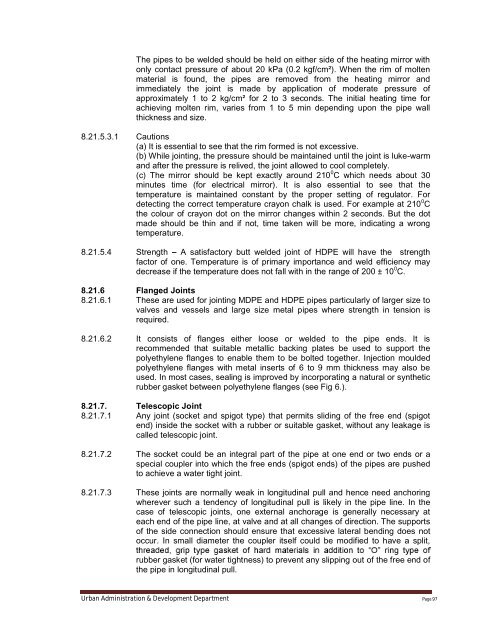Specifications Part 1 - Water Supply, Sewerage and Tube Well Works
Specifications Part 1 - Water Supply, Sewerage and Tube Well Works
Specifications Part 1 - Water Supply, Sewerage and Tube Well Works
Create successful ePaper yourself
Turn your PDF publications into a flip-book with our unique Google optimized e-Paper software.
The pipes to be welded should be held on either side of the heating mirror withonly contact pressure of about 20 kPa (0.2 kgf/cm²). When the rim of moltenmaterial is found, the pipes are removed from the heating mirror <strong>and</strong>immediately the joint is made by application of moderate pressure ofapproximately 1 to 2 kg/cm² for 2 to 3 seconds. The initial heating time forachieving molten rim, varies from 1 to 5 min depending upon the pipe wallthickness <strong>and</strong> size.8.21.5.3.1 Cautions(a) It is essential to see that the rim formed is not excessive.(b) While jointing, the pressure should be maintained until the joint is luke-warm<strong>and</strong> after the pressure is relived, the joint allowed to cool completely.(c) The mirror should be kept exactly around 210 0 C which needs about 30minutes time (for electrical mirror). It is also essential to see that thetemperature is maintained constant by the proper setting of regulator. Fordetecting the correct temperature crayon chalk is used. For example at 210 0 Cthe colour of crayon dot on the mirror changes within 2 seconds. But the dotmade should be thin <strong>and</strong> if not, time taken will be more, indicating a wrongtemperature.8.21.5.4 Strength A satisfactory butt welded joint of HDPE will have the strengthfactor of one. Temperature is of primary importance <strong>and</strong> weld efficiency maydecrease if the temperature does not fall with in the range of 200 ± 10 0 C.8.21.6 Flanged Joints8.21.6.1 These are used for jointing MDPE <strong>and</strong> HDPE pipes particularly of larger size tovalves <strong>and</strong> vessels <strong>and</strong> large size metal pipes where strength in tension isrequired.8.21.6.2 It consists of flanges either loose or welded to the pipe ends. It isrecommended that suitable metallic backing plates be used to support thepolyethylene flanges to enable them to be bolted together. Injection mouldedpolyethylene flanges with metal inserts of 6 to 9 mm thickness may also beused. In most cases, sealing is improved by incorporating a natural or syntheticrubber gasket between polyethylene flanges (see Fig 6.).8.21.7. Telescopic Joint8.21.7.1 Any joint (socket <strong>and</strong> spigot type) that permits sliding of the free end (spigotend) inside the socket with a rubber or suitable gasket, without any leakage iscalled telescopic joint.8.21.7.2 The socket could be an integral part of the pipe at one end or two ends or aspecial coupler into which the free ends (spigot ends) of the pipes are pushedto achieve a water tight joint.8.21.7.3 These joints are normally weak in longitudinal pull <strong>and</strong> hence need anchoringwherever such a tendency of longitudinal pull is likely in the pipe line. In thecase of telescopic joints, one external anchorage is generally necessary ateach end of the pipe line, at valve <strong>and</strong> at all changes of direction. The supportsof the side connection should ensure that excessive lateral bending does notoccur. In small diameter the coupler itself could be modified to have a split,rubber gasket (for water tightness) to prevent any slipping out of the free end ofthe pipe in longitudinal pull.Urban Administration & Development Department Page 97
















